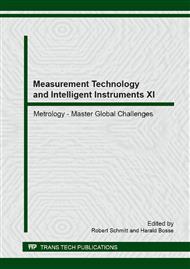[1]
D. Goleman, Emotional Intelligence: Why It Can Matter More Than IQ, Bantam Books, (1996).
Google Scholar
[2]
W. Piston, Harmony, Victor Collancz Ltd., London, (1950).
Google Scholar
[3]
H. Schenker, Harmony, the University of Chicago Press, Chicago and London, (1954).
Google Scholar
[4]
V. Elkin, Curative (medical) magic of music. Harmony of colour and sound in therapy of disease, Respects, St. Peetersburg, 2000 (in Russian).
Google Scholar
[5]
H. Von Loesch, F. Brinkmann, Das tempo in Beethovens Appassionata von Frederic Lamond (1927).
Google Scholar
[6]
I.A. Volodin, E.V. Volodina, S.S. Gogoleva, L.O. Doronina, Indicators of emotional arousal in vocal emissions of the humans and nonhuman mammals, Journal of General Biology 70 3 (2009) 210-224.
Google Scholar
[7]
H. Oelmann, B. Laeng, The emotional meaning of harmonic intervals, Cognitive Processing 10 (2009) 113-131.
DOI: 10.1007/s10339-008-0217-z
Google Scholar
[8]
K. Sapozhnikova, R. Taymanov, About a measuring model of emotional perception of music, in: Proceedings of the XVII IMEKO World Congress, 22-27 June 2003, Dubrovnik, Croatia, 2003, p.2049-(2053).
Google Scholar
[9]
K. Sapozhnikova, R. Taymanov, Multiparametric measurements of emotions, in: Proceedings of the XIX IMEKO Congress on Fundamental and Applied Metrology, 6-11 September 2009, Lisbon, Portugal, 2009, p.1180—1185.
Google Scholar
[10]
R. Taymanov, K. Sapozhnikova, Improvement of traceability of widely-defined measurements in the field of humanities, Measurement Science Review 10 3 (2010) 78-88.
DOI: 10.2478/v10048-010-0014-6
Google Scholar
[11]
C.U.M. Smith, Biology of Sensory Systems, John Wiley & Sons, Chichester, (2000).
Google Scholar
[12]
V.K. Labutin, A.P. Molchanov, Models of Audition Mechanisms, Energia, Мoscow, 1973 (in Russian).
Google Scholar
[13]
C.E. Izard, The Psychology of Emotions, US Springer, (1991).
Google Scholar
[14]
F.E. Bloom, C.A. Nelson, A. Lazerson, Brain, Mind, and Behavior, 3rd edition, W.H. Freeman & Co, (2005).
Google Scholar
[15]
G. Buzsaki, Rhythms of the Brain Oxford University Press, (2006).
Google Scholar
[16]
G.G. Knyazev, Motivation, emotion, and their inhibitory control mirrored in brain oscillations, Neuroscience and Biobehavioral Reviews 1 (2007) 377–395.
DOI: 10.1016/j.neubiorev.2006.10.004
Google Scholar
[17]
K. Sapozhnikova, R. Taymanov, Improvement of traceability of widely-defined measurements in the field of humanities, in Proceedings of the International Symposium on Measurement Technology and Intelligent Instruments (ISMTII-2009), 29 June – 2 July 2009, St. Petersburg, Russia, 2009, pp.4-243.
DOI: 10.2478/v10048-010-0014-6
Google Scholar
[18]
K. Sapozhnikova, R. Taymanov, Role of measuring model in biological and musical acoustics, in: Proceedings of the 10th International Symposium on Measurement Technology and Intelligent Instruments (ISMTII-2011), 29 June- 2 July 2011, Daejeon, Korea, 2011, D5-5, 6 p.
Google Scholar
[19]
I. Ganzelka, M. Zikmund, Africa of Dreams and Reality, Leningrad, (1958).
Google Scholar
[20]
T. Fritz, S. Jentschke, N. Gosselin, D. Sammler, I. Peretz, R. Turner A.D. Friederici,S. Koelsch, Universal recognition of three basic emotions in music. Curr. Biol., 19 7 (2009) 573-576.
DOI: 10.1016/j.cub.2009.02.058
Google Scholar
[21]
K. Sapozhnikova, R. Taymanov, Acoustic riddles of cultural heritage, in: Proceedings of the International Conference Digital Preservation and Presentation of Cultural and Scientific Heritage, 11-14 September 2011, Veliko Tarnovo, Bulgaria, 2011, pp.79-90.
DOI: 10.55630/dipp.2011.1.9
Google Scholar
[22]
Church Bells. Spirit Music. CD-ROM, OOO Monolit-trading.
Google Scholar


